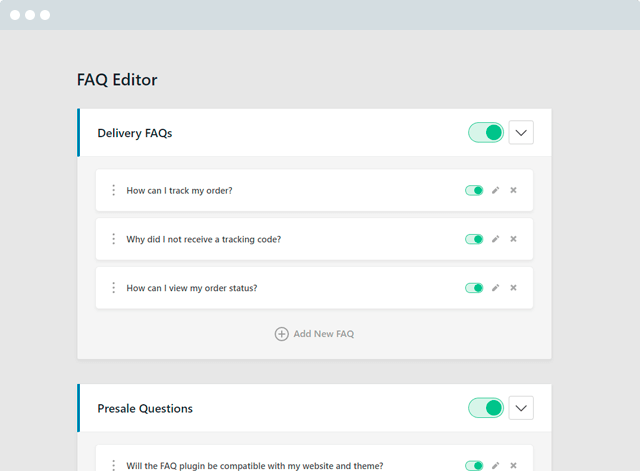The key to meaningful FAQs lies in framing its questions just as the users ask them. So, here are 3 practical question writing hacks to stop poor questions from stealing the effectiveness of your FAQs.
#1. Use ‘I’s when framing the questions
If you’ve noticed some of the best FAQs, you’ll see that they have the questions written in the first person.
Now, this is so for a reason. To understand it, just read the following two questions and choose the one that sounds more appealing:
- “How can I integrate your product with PayPal?”
- “How does your product integrate with PayPal?”
They’re both the same, but if you think like a user, you’re much likely to go with the first option and not with the second.
What works for the first question format is that it matches with how a user actually thinks through the query. The second way of putting the question, however, looks like it comes from the site’s documentation writer.
Jonathan and Lisa Price, authors of the book, Web Writing That Works! call such questions “bad” and say:
Bad questions are self-centered. They reflect the site’s concern with its own policies, concepts, and values. These questions do not sound like what a guest might ask.
So, when you write questions to include in your FAQs, use formats like:
- How can I ____?
- Can I _____?
- What are my ____?

Build an FAQ and help answer common visitor questions.
Get the Plugin
#2. Start with a question word
When users click a link to FAQs, they expect to see questions and answers. Because that’s how FAQs are supposed to be.
But a lot of sites don’t use the question/answer format for their FAQs. Instead of questions and answers, their FAQs are either full of statements (and responses to those statements!) or a mix of questions and statements.
If you use statements or labels instead of questions, your FAQs look a little off.
Let’s take an example. Suppose that you sell an accounting software, and your users repeatedly ask you if your product can collect payments via PayPal.
Now, when you add this topic to your FAQs, go with a question like: “Can I use PayPal to collect payments? and not with a label like: “Collecting payments with PayPal.”
For every common query that you get, use one of the following question words to form your FAQs:
- What
- How
- Which
- When
- Where
- Whom
- Can
- Why
#3. Write in the language of your users
When jargon creeps into FAQs, they stop being clear. Often such gobbledygook requires the users to unwind the questions in their minds to really get what you’re trying to say. And as a result, your FAQ user experience suffers.
Now, suppose that in our accounting solution example, another common user question that you get is if the users can use Stripe to collect money. In technical terms, what they’re really asking you is if you support Stripe as a payment gateway.
But you add this query to your FAQs, don’t use these technical terms. Always go with how the users put them.
In this example, you could say: “Can I use Stripe to collect payments?”. Avoid: “Can I use Stripe as a payment gateway?”
You get the idea, right?
The easy part about applying this tip is that you already know the words and the language your customers use for asking questions. All you need to do is to reflect the same in your FAQs.
So, the next time that you add a question to your FAQs, pick words from the user’s support tickets or queries.
Conclusion
When writing questions for your FAQs, think like a customer. Because it’s only when you do so that you’ll be able to connect with them. Otherwise, even your best FAQ content will fail.
So, how do you write your FAQs? Do share in the comments!
P.S. Once you’re done with the questions, your next step will (obviously) be to write the answers. We’ve covered 5 effective ways to answer FAQs in one of our earlier posts called: 5 Simple Ways to Write the Perfect Answers to Your FAQs. Do check it out!
The post How to Write Frequently Asked Questions appeared first on HeroThemes.
